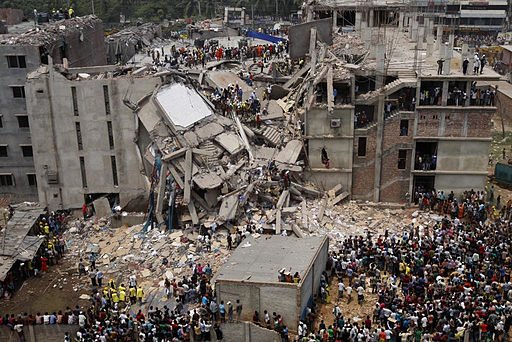
On the third anniversary of the Rana Plaza collapse, Rob Wayss, the Accord’s executive director, talks to James Irwin, head of health & safety recruitment at Acre about progress on one of the Accord’s core commitments: setting up democratically elected safety committees in factories.
In September, Acre interviewed Brad Loewen, the chief safety inspector for the Bangladesh Accord on Fire and Building Safety. An independent agreement designed to make all garment factories in Bangladesh safe, the Accord came into being following the collapse of the Rana Plaza building on 24th April 2013 in which more than 1,100 people were killed and over 2,500 injured.
James: When we spoke with Brad back in September, he said that the Accord’s next challenge was setting up occupational safety committees. Why are these safety committees so important?
Rob: In the agreement it states that we will require democratically elected health and safety committees in all factories to help maintain and monitor health and safety at the factory level. It was included as one of the major components of the agreement because the long-term safety of workers in the Bangladesh apparel industry will depend, not just on safety inspections, but on creating a culture of safety for workers.
We’re in the early stages of this part of the implementation of the Accord and understand that realising functional safety committees at our approximately 1,750 listed factories over the next 2+ years is a major undertaking. We are confident the work we are doing with safety committees is creating an effective model that can be implemented on a wide scale. The Accord has started our safety committee work in 52 unionised factories and will soon expand to covered factories where there is no union.
James: Can you talk me through how the safety committees work?
Rob: The committees are made up of equal members of worker representatives and management representatives. The committee members play a crucial role in monitoring safety and health issues on a day-to-day basis and creating that culture of safety I mentioned. So for example, they’ll be checking that fire doors are closed, exits routes are not obstructed, equipment is maintained, and they’ll regularly check for any potential hazards or maintenance issues. The committee members will raise identified concerns with management so that they can be remediated.
James: How prepared are employee members of the safety committee to take on these additional responsibilities?
Rob: The Accord is working to build the capacity of the safety committees to function effectively. This work is in its early stages however. The safety committee members are workers, elected by their peers, and managers who are interested in leading on safety at their factory. They jointly receive a seven session training program from the Accord on supporting remediation, hazard identification, complaints handling, joint problem solving and workplace safety monitoring. Almost 100 training sessions have been held in 31 factories so far.
It’s important to add though that it’s not just the employees and managers on the committees who receive training. While those who are elected get more detailed instruction and the addition of training specific to their committee role, the Accord presents to all employees, telling them about the new committee, how it will work and how to contact them – we also give each employee a booklet containing all of that information to take away. Approximately 48,000 workers and managers at Accord listed ready made garment factories have participated in the all employee meetings. We need all employees on board with the safety agenda – not just the ones elected to the committee.
James: How many committees have been set up so far?
Rob: The programme is underway in 52 factories with a registered trade union and active Accord signatory companies. Approximately 1,750 factories produce for the Accord but only about 80 of them have trade unions. We are will soon expand the safety committee work to cover factories where there is no union. It is a major undertaking and we are committed to this important piece of the Accord agreement and to helping build effective safety committees at the covered factories.
James: Why has the focus shifted to the committees now?
Rob: Our first priority was the independent inspection programme of the factories that produce for Accord signatory companies. We’ve now inspected all of those factories to identify fire, electrical, and structural safety hazards and are working to remediate the identified safety hazards. The next logical progression is to support a functional labour management structure and systems at the factory to monitor and maintain safety.
James: Are conditions for apparel workers in Bangladesh changing for the better?
Rob: I think they are. Listed factories have been inspected, safety hazards identified, remediation is taking place, safety committees are being supported and workers are receiving more information on safety issues and how they can help monitor safety. Most owners are showing commitment to build safety into their factories and they are receiving a tremendous amount of support from the Accord and our signatories in all of this.
James: Does the Accord have teeth when factories don’t comply?
Rob: Our approach is always to try to help first. Sometimes it’s just a case of providing the right information and guidance to get factory owners on the right track, but yes, there is a punitive side too. If issues that compromise people’s safety aren’t addressed then, after a good faith effort by the Accord and our signatories, that factory becomes ineligible to produce for Accord brands. Most factory owners don’t want to lose business relationships so they co-operate.
James: What happens to those who refuse to co-operate?
Rob: In addition to becoming ineligible for business with Accord signatory companies, the factory is disclosed on our website. The Accord then informs the Ministry of Labour (MoLE) of the status of this factory. It then becomes important but also a challenge that the MoLE monitor the safety at these factories
The penalty for non-compliance with the Accord requirements is severe so we expect the number of factories that reach this point will not be very large. Those that do reach this point due to an unwillingness to meet safety requirements will find it hard to survive, but not having such manufacturers continue in the industry is not a bad thing.
 Rob Wayss is the executive director of the Accord on Fire and Building Safety in Bangladesh. Rob has 20 years experience in the US, Europe, Asia, and Central America as a labour and industrial relations practitioner and in promoting fundamental workplace rights.
Rob Wayss is the executive director of the Accord on Fire and Building Safety in Bangladesh. Rob has 20 years experience in the US, Europe, Asia, and Central America as a labour and industrial relations practitioner and in promoting fundamental workplace rights.
Rob has performed this work in various capacities with the New York City Mayor’s Office of Labor Relations, the American Center for International Labor Solidarity (AFL-CIO), the US public employee unions (AFSCME), and the International Labour Organization (ILO). He has taught labour relations courses at Empire State College (SUNY). He served as an agricultural extension volunteer with the US Peace Corps in Lesotho, Southern Africa (1991-93).
Rob has a Masters degree in Labor and Industrial Relations from the University of Rhode Island. He has lived and worked in Bangladesh for 8 ½ years.
 James Irwin leads the health, safety and environment recruitment function at global sustainability recruitment specialists, Acre. In addition to leading the team, James recruits senior health, safety and environment professionals globally. In 2013, James launched the Senior Women in Sustainability, Safety and Environment (WISSE) network and the Senior Ex-Forces in Safety Network, both platforms which brings together senior safety professionals with a shared background to engage, network and share ideas.
James Irwin leads the health, safety and environment recruitment function at global sustainability recruitment specialists, Acre. In addition to leading the team, James recruits senior health, safety and environment professionals globally. In 2013, James launched the Senior Women in Sustainability, Safety and Environment (WISSE) network and the Senior Ex-Forces in Safety Network, both platforms which brings together senior safety professionals with a shared background to engage, network and share ideas.
The Safety Conversation Podcast: Listen now!
The Safety Conversation with SHP (previously the Safety and Health Podcast) aims to bring you the latest news, insights and legislation updates in the form of interviews, discussions and panel debates from leading figures within the profession.
Find us on Apple Podcasts, Spotify and Google Podcasts, subscribe and join the conversation today!




